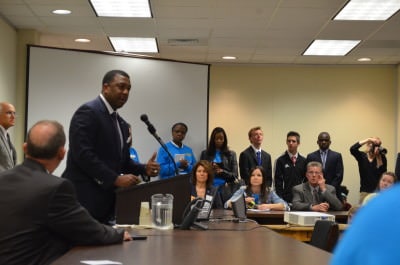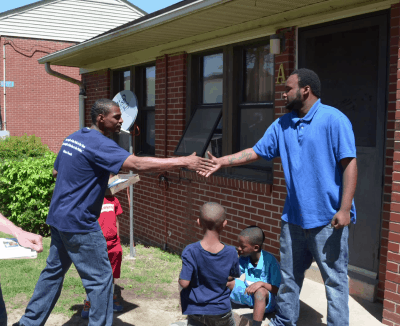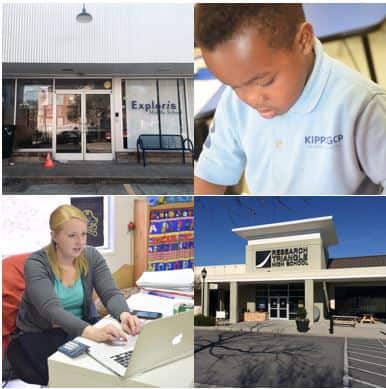Misperceptions and misunderstanding about public education in general and the Charlotte-Mecklenburg Schools in particular are common. Introducing the topic of school desegregation to the discussion can provoke strong opinions and can make the debate even more explosive.
Three scholars, Roslyn Mickelson, Stephen S. Smith and Amy Hawn Nelson, have researched topics related to Charlotte-Mecklenburg Schools and school desegregation for decades. They have just edited a new book on the issue, Yesterday, Today, and Tomorrow. School Desegregation and Resegregation in Charlotte and recently appeared on “Charlotte Talks” on WFAE. Here, they answer some questions:
Q. What are some key misconceptions and empirical realities about public education and Charlotte-Mecklenburg Schools?
This often-repeated statement, “Our public school system is broken,” is not rooted in data but in personal opinion, anecdotes or partisan ideology. Most important, repeating this fiction weakens public schools and public support for public schools.
A. First, it’s important to keep in mind that CMS and public education are not “broken.” This often-repeated statement, “Our public school system is broken,” is not rooted in data but in personal opinion, anecdotes or partisan ideology. Most important, repeating this fiction weakens public schools and public support for public schools.
Yes, some schools are terrible – mainly those that are high poverty or racially segregated – but most public schools are good, and many are superb. Overall, public schools are superior to private schools. Lubienski & Lubienski (2014) used current, large-scale, nationally representative datasets to better understand the outcomes of private and public schools. After controlling for demographics, the Lubienskis showed that gains in student achievement in public schools are equal to, or greater than those in private schools.
CMS is widely considered one of the highest performing urban districts in the nation and has received many national awards, including the prestigious Broad Prize in 2011. Just last month, 20 out of 37 magnet schools in CMS were recognized by Magnet Schools of America as schools of excellence or distinction. Last year, CMS fourth-graders outperformed their peers in all other “urban” districts in math on the National Assessment of Educational Progress (NAEP), a ranking that looks only at large urban districts, comparing apples to apples, so to speak, instead of comparing CMS to suburban or rural districts with different racial or economic demographics.
Of 115 districts in North Carolina, CMS consistently performs in the middle of the pack. While CMS has some hyper-segregated, high-poverty schools whose outcomes are far worse than schools in some suburban or rural districts, it’s also the case that many CMS schools outperform schools in surrounding counties such as Cabarrus and Union.
Q. What other misconceptions and realities about public schools are highlighted in your work?
A. There is a misconception that racially and economically diverse schools cannot be excellent schools. The opposite is true. There is strong, consistent social science evidence of the benefits of diverse schools and the harm from segregated schools:
- Racially and socioeconomically diverse schools are superior to segregated ones in terms of academic outcomes (better test scores, college attendance and graduation rates) and nonacademic outcomes (such as greater occupational and income attainment, decreases in racism and fears) in the short-term and across the course of life.
- A diverse student body across racial, linguistic and socioeconomic lines is more cost-effective for overall school improvement than current strategies that focus on providing additional support to low-performing (predominantly segregated) schools.
- The harms of segregated schooling and benefits of diverse education accrue not just to the individual student who experiences it, but also to the larger community and society.
- Do we want our children and grandchildren to live in a community where everyone is literate and numerate and career- and college-ready? Or in one where a large number of people are only marginally literate and numerate? Evidence is overwhelming that the former outcomes are associated with diverse schools and the latter ones are directly linked to segregated schools of poverty.
- Recent research on economic mobility points to integrated schools and neighborhoods as essential features of intergenerational upward mobility. 1
Q. If desegregated schools are so much better and the CMS plan was so successful, why did CMS resegregate?
A: There are many reasons for CMS’s resegregation.
Civic, corporate, educational, religious, school district and neighborhood leaders have accepted segregated schools and the challenges and harms associated with them.
We, as a community, chose inaction following U.S. District Judge Robert Potter’s 1999 decision in a case that challenged CMS desegregation policies. We allowed our schools to resegregate. Civic, corporate, educational, religious, school district and neighborhood leaders have accepted segregated schools and the challenges and harms associated with them: Segregated schools are highly effective delivery systems for unequal education.
Importantly, the resegregation of CMS, like its desegregation four decades ago, is not the result of the actions of any single person or organization. It was, and is, something for which the whole community has been responsible: corporate, civic and religious groups, the voters who elect the school board, and the school board itself. Among the people and decisions responsible for CMS’s resegregation are:
1. CMS’s nationally praised busing plan of the 1970s and 1980s fueled local economic development, but when desegregation conflicted with development, development typically triumphed. Among those triumphs was the decision to build the southern portion of the Interstate 485 outerbelt highway in a location that fueled development in outlying portions of the county, where it was hard to desegregate outlying neighborhoods and schools.
2. There has been and continues to be too little affordable housing in many parts of the county. This contributes to a shortfall in residential diversity that, in turn, makes it harder to desegregate schools. Housing policy is often de facto school policy.
3. Because of inadequate funding, CMS sometimes had to buy or accept developers’ gifts of land for the construction of new schools whose location made them hard to desegregate. Many of those sites violated CMS policy of buying school land only in locations that facilitate diversity.
4. Many Charlotte newcomers were accustomed to more racially and socioeconomically homogeneous districts, and they pressured CMS to end desegregation efforts.
5. In a 1999 trial, U.S. District Judge Robert Potter issued an order requiring CMS to stop taking race into account in pupil assignment, even though a majority of the school board wanted to continue taking it into account.
6. Even though Potter’s order required CMS to stop considering race in pupil assignment, nothing in the order prohibited CMS from actively pursuing diversity through socioeconomic status, as the Wake County (Raleigh) school system has done, largely successfully. CMS’s board declined to consider socioeconomic status as a tool for creating diverse school assignments.
7. There is little encouragement for racial or socioeconomic diversity among the billionaires and their foundations (Walton Foundation, Broad Foundation, Gates Foundation) whose funding shapes today’s public education reform efforts.
Q: What can we do as a community in response to these trends?
A: CMS has two choices:
The first choice is to continue on the same road it’s been on since 2002, with minimal attention to alleviating resegregation. This approach accepts socioeconomic and racial segregation and hopes and prays that some new reforms will have systematic and lasting positive consequences.
The second choice would be to take steps to reverse socioeconomic and racial segregation and thereby improve education for all children. Specific educational reforms that could decrease racial and socioeconomic segregation include:
1. Addressing second-generation segregation that manifests as tracking and ability grouping; de-track and employ complex instruction in heterogeneous classrooms.
2. Siting new schools where it’s easier to draw a diverse student body.
3. When opening new schools, drawing attendance boundaries in ways that facilitate diversity.
4. Using partial magnets strategically.
5. Recalibrating priorities in the current CMS School Board Guiding Principles for Student Assignment 2
6. Promoting authentic diversity through staffing and curricula choices.
Additionally and more ambitiously:
7. Revisiting and revising the system’s pupil assignment guiding principles so they include stability, proximity, utilization and diversity across racial, linguistic and socioeconomic lines.
References:




